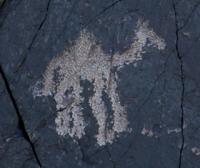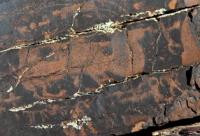Вы здесь
Petroglyphs in gorge Shokpar.


Petroglyph Travels in Kazahtsan.
“The world is a book and those who do not travel read only one page”
Augustine of Hippo.
Petroglyph Walking in Kazakhstan.
The Chokpar tract is located 1.5 km south of the Alaigyr station of the Kurdai district of the Dzhambul region in a wide valley near the northern slope of the Kindyktas mountains. It is a narrow canyon with a river of the same name.
Rocks with petroglyphs were found 3 km west of the entrance to the tract from the Sartai valley. Rock carvings are carved into small rock blocks on both banks of the river. Most of them are concentrated on the left southern bank in a small gorge.
For the last decades as a result of archaeological investigations both the large congestions of petroglyphs, and small containing not less interesting material for researchers are found. Congestions of rock drawings of a steppe zone by convention are called "sanctuaries" in the adjective designating concepts small, small, insignificant.
Among such monuments it is possible to call petroglyphs of the gorge Shokpar in whose studying the staff of Institute of archeology of name A.H was engaged. Margulan and I, the junior researcher of the Museum of archeology "Gylym Ordasy" according to the program of basic researches.
Petroglyphs were found on rocks of a narrow canyon of the stream Shokpar proceeding in the meridian direction. From east and western parties of a canyon valleys which the local population calls Sartay and Boribay are located.
Materials of culture of tribes of an era of bronze, the early Iron Age and Middle Ages, burial grounds, site ancient and rock paintings are brightly presented to the gorge. On rocks - drawings of single animals and in compositions.
The ancient group of them treats a bronze era. It, first of all, images of wild bulls tours, camels, horses, arkhar, goats, dogs, men in scenes of "single combat". Similar plots meet on numerous monuments of nearby regions.
In the gorge Shokpar among petroglyphs of an era of bronze the brightest are scenes with bulls. They are united also by some stylistic signs: at bulls unnaturally extended curved horns, on the massive case the scapular hump is looked through, on the ends of tails brushes in the form of spheres are noticeable.
All these signs are known also in petroglyphs of the Tamgaly and Kulzhabasy where they are dated a bronze era. From this similarity there was a name "Tamgaly tradition" of petroglyphs of an era of bronze. The plot with prosecution by predators of herbivores is more characteristic of the early Iron Age and definition as "a scene of a torment" has.
However the iconographic features of the image of bulls typical for the earliest group of petroglyphs of the Tamgaly allow researchers to consider that this motive in petroglyphs art gained development much earlier, during a bronze era.
Semantic similar plots are connected with a cult of a bull. It is possible to distinguish layer of petroglyphs which is defined as intermediate between drawings of an era of bronze and Saksk time from a complex. Plots with camels who are duplicated also in the early Iron Age concern to them.
Two-humped camels in the gorge about 20 figures are noted. Large planimetric are executed beat out also to grind. The found drawings of camels in the gorge are defined as the image of wild animals. It and certain camels, and in pack, and a female camel with a colt.
Existence in a bronze era plot at one camel of a certain similarity of a harness, escort of the second a dog allows to assume that domestic camels are shown. An image of a camel of a Bactrian - a widespread plot of petroglyphs art of Kazakhstan and Central Asia.
Here the camel was house and was used as a riding and draft animal, according to experts, already in the period of Andronovsk and a Tazabaga-Yabsky cultures in II thousand BC. A series of figures of goats and arkhar belongs to medieval petroglyphs, a part was drawn in the early Iron Age and significantly renewed later, a tamga figurative signs can be carried here.
In composite unity with the image of herd of goats there is a Ϩ-figurative sign where the small thickening in the top end and thin lower is allowed to assume that this image of a snake. Such image is on not absolutely usual monument - a turtle from the Mukharsky funeral complex on the river Tola.
To the northeast of inhabited and economic constructions on an extreme rocky ridge the image of a tamga is found. In view of conditions in places of existence of "sanctuaries" Shokpar, it is possible to say with a big share of confidence that its inhabitants were engaged in cultivation of the cattle and this place represents a constant farmstead of cattle-farmers.
The main religious motives of honoring of sacred animals in the gorge Shokpar, as well as other small complexes, remain invariable. Such situation only emphasizes traditional character of a way of life of ancient cattle-farmers of Zhetysu throughout several historical periods.
Geographic coordinates of the Shokpar petroglyphs: N43 ° 48'09.39 "E74 ° 25'55.27"
Authority:
Ksenia Egorova, junior researcher of the Museum of archeology, RGP "Gylym Ordasy", https://e-history.kz/ru/contents/view/1856
Literature:
1. Maximova A. G., Yermolaeva A. S., Maryashev A. N. Rock drawings of the natural boundary of the Tamgaly. Alma-Ata, 1985.
2. Maryashev A. N., Goryachev A. A. Rock drawings of Semirechya. Almaty, 2002.3. Maryashev A. N., Goryachev A. A. Rock drawings of Semirechya. Almaty, 2002.
3. Klyashtorny S. G., Savinov D. G. Steppe empires of ancient Eurasia. SPb., 2005.
Photos
Alexander Petrov.







